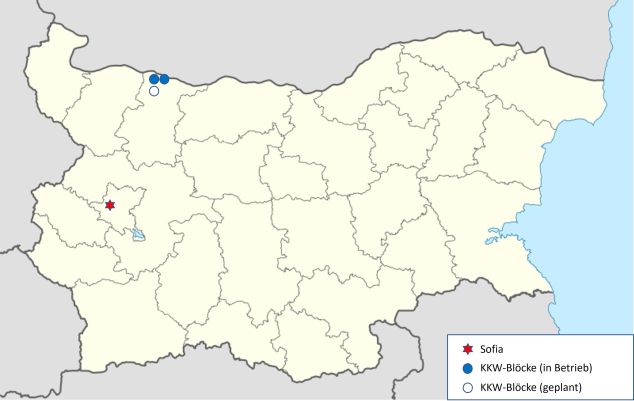Nuclear Energy in Bulgaria (04.05.2023)
• NuScale Power's majority shareholder has entered into an agreement with Bulgaria's state-owned utility for a potential deployment of Small Modular Reactors (SMRs).
Status quo of electricity generation
In Bulgaria, the Kozloduy NPP operates two reactor units of the Russian VVER-1000 (V-320) type, each with an electrical output of 1,000 megawatts (MW): Kozloduy 5 and 6. Units 1 to 4 (VVER-440/230) were shut down in 2002 and 2006, respectively, in the context of Bulgaria's accession to the European Union; Units 5 and 6 underwent extensive modernisation by 2007.

In earlier years, Bulgaria exported a significant share of domestically generated electricity. Although this share has decreased, Bulgaria is still a net exporter of electrical energy (almost 6 terawatt hours in 2019).
Political and legal framework
The current Bulgarian government attaches great importance to nuclear power for the country's future energy supply. In the negotiations on the "EU taxonomy", it advocated that both nuclear power and electricity generation from gas be classified as sustainable in the sense of the taxonomy. New-build plans have been pursued for many years (see paragraph below), but have so far failed, in particular due to a lack of funding. State funding for new construction projects is still ruled out.
In addition, the government is seeking an extension of the operating lives of the two units still in operation at Kozloduy. After a 10-year extension of the operating lives, the two reactors may still be operated until 2027 and 2028 respectively; the operator had already considered an extension until 2047 possible in the context of the licensing procedure at the time.
Current plans and projects
Large NPPs. At the Belene site, construction of a Russian VVER-1000 (V-320) had already begun in 1987. However, the project was terminated in 1991 due to lack of financing, after a significant part of the technical equipment had already been delivered and some of the construction work had been done. In 2008, a new contract was concluded for the construction of two VVER-1000 (AES 92) reactor units, on the basis of which construction work was again carried out in the following years and technical equipment (including two reactor pressure vessels) was delivered on a larger scale. Due to difficulties with financing and changing governments, this project also came to a standstill in 2012. In 2013, the then government announced a halt to the project, but the next government intended to re-examine it. In June 2016, the International Court of Arbitration awarded 620 million euros to Atomstroyexport for deliveries already made. In mid-2018, the Bulgarian parliament voted to resume the project on the government's proposal; by mid-2020, several companies or consortia had expressed interest in investing in or building the plant. A formal decision on construction at the Belene site has not yet been made.
Laufzeitverlängerungen. Die beiden Reaktoren am Standort Kosloduj dürfen nach einer Verlängerung der Laufzeiten um zehn Jahre noch bis 2027 und 2028 betrieben werden. Der Betreiber hatte im damaligen Genehmigungsverfahren bereits eine Verlängerung bis 2047 für möglich gehalten.
Ende Juli 2024 hat die bulgarische Aufsichtsbehörde BNRA für Kosloduj-5 und -6 zudem unbefristete Betriebsgenehmigungen ausgestellt. Die Anlagen müssen gemäß den Anfang 2024 verabschiedeten Änderungen des Atomgesetzes jedoch mindestens alle zehn Jahre periodische Sicherheitsüberprüfungen durchlaufen.
Ende April 2024 hat BNRA die Genehmigung für einen schrittweisen Übergang zu einem neuen amerikanischen Kernbrennstofftyp für Block 5 des KKW Kosloduj erteilt. Die Umstellung auf den neuen Kernbrennstoff, der kurz zuvor erstmals geliefert wurde, soll vier Jahre dauern.
Große Kernkraftwerke. Am Standort Belene wurde bereits 1987 mit dem Bau eines russischen WWER-1000 (V-320) begonnen. Das Projekt wurde jedoch 1991 wegen fehlender Finanzierung beendet, nachdem bereits ein signifikanter Teil der Technik geliefert und ein Teil der Bauarbeiten geleistet worden war. Im Jahr 2008 wurde ein neuer Vertrag über den Bau zweier Reaktorblöcke vom Typ WWER-1000 (AES 92) geschlossen, auf dessen Grundlage in den folgenden Jahren wiederum Bauarbeiten durchgeführt und in größerem Umfang technische Einrichtungen (u. a. zwei Reaktordruckbehälter) geliefert wurden. Aufgrund von Schwierigkeiten bei der Finanzierung und wechselnden Regierungen wurden die Pläne für den Neubau 2023 annulliert.
Anfang 2021 verabschiedete das bulgarische Parlament einen Plan zum Bau neuer Reaktorblöcke am Standort Kosloduj. Beauftragt damit ist die dafür eigens gegründete Firma Kozloduy NPP – New Builds. Bei dem Neubau sollen teilweise Komponenten aus Belene verwendet werden. Nachdem die bulgarische Atomaufsichtsbehörde BNRA den Standort bereits für einen Neubau genehmigt hatte, muss nach Angaben von BNRA-Vertretern von März 2024 eine erneute Überprüfung der Standortgenehmigung beantragt werden, um Block-8 errichten zu dürfen. Dieser Antrag wurde im Februar 2025 eingereicht. Die bereits erteilte Standortgenehmigung für Block-7 müsse spätestens im Jahr 2025 aktualisiert werden.
Im November 2024 unterzeichnete Kozloduy NPP – New Builds mit dem südkoreanischen Unternehmen Hyundai Engineering & Construction und mit dem US-amerikanischen Unternehmen Westinghouse einen Ingenieurvertrag für den Bau von zwei AP1000 im bulgarischen KKW Kozloduj. Der Vertrag umfasst die Standortplanung für die beiden Reaktoren, Genehmigungen, Projektplanung und die Entwicklung von Betrieb und Wartung. Innerhalb von zwölf Monaten sollen die Zeitplan- und Finanzdetails für den Neubau festgelegt werden.
Die Blöcke sollen Regierungsangaben von November 2023 zufolge bis 2033 fertiggestellt werden.
SMR. Das US-amerikanische Unternehmen Flour, das die Mehrheit an NuScale Power hält, hat im Jahr 2021 mit dem staatlichen Energieversorger (Bulgarian Energy Holding) eine Vereinbarung über den potenziellen Einsatz des NuScale SMR geschlossen. Geprüft werden sollen sowohl der Bau solcher Anlagen am Standort Kosloduj als auch deren Einsatz für ein sogenanntes Repowering von Kohlekraftwerken, das heißt den Ersatz letzterer unter Nutzung der bereits vorhandenen Infrastruktur (insbesondere der Netzanbindung).
Forschungsreaktor
Am Institut für Kernforschung und Kernenergie der bulgarischen Akademie der Wissenschaften in Sofia wurde von 1961 bis 2008 ein Forschungsreaktor des Typs IRT-2000 betrieben. Der Poolreaktor wurde vom russischen Kurtschatow-Institut errichtet und ursprünglich mit hochangereichertem Uran (36 Prozent Anreicherungsgrad) betrieben. 2008 wurde der Reaktor abgeschaltet, um mit verändertem Design umgebaut zu werden. Aufgrund fehlender Finanzierung wurde das Projekt jedoch bis heute nicht beendet.
(Stand: März 2025)
